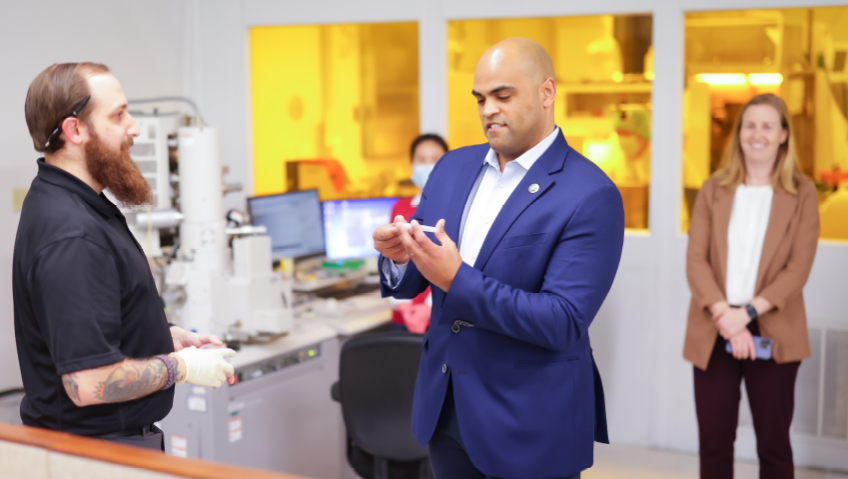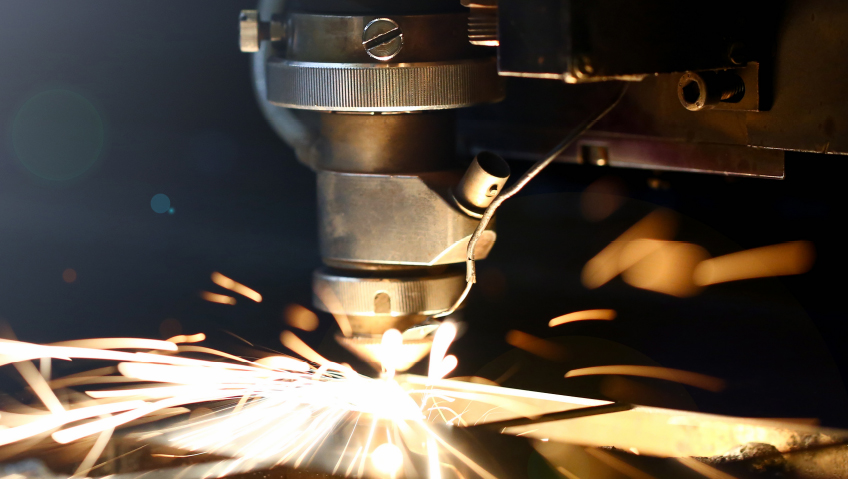Back in March, Congressman Colin Allred toured Photodigm’s facilities in Richardson, Texas, and liked what he saw. A member of the U.S. House of Representatives from Texas’s 32nd district, Congressman Allred’s visit underscored the importance of America’s CHIPS and Science Act.
Signed into law by President Joe Biden last August, the Act will see some $280 billion in new funding for the domestic research and manufacturing of semiconductors in America. The bipartisan legislative package will see greater investment in America’s semiconductor research, manufacturing and supply chains, and job creation.
For President and Chief Executive Officer Bill Stuart and the team at Photodigm, seeing the enthusiasm on the Congressman’s face and hearing the excitement in his voice during the tour was further assurance the company is on the right track.
“We were incredibly honored and grateful to have Congressman Colin Allred visit Photodigm,” Stuart said during the tour. “It’s clear that he understands the crucial importance of our innovative semiconductor chip technology and is incredibly quick to grasp the real-world challenges companies like ours face as we scale production of our leading-edge photonic chips to meet customer demand.”
100% American-owned
Stuart is quick to praise his staff past and present. Before coming on board about a year and a half ago, he spent some 30 years in technology, mainly on the software side until a decade ago, when he set up a venture fund and conducted private investing in hardware-related companies, including Photodigm.
During the COVID-19 crisis, many businesses were affected by supply chain issues and disruptions. Not a day went by without news of the worldwide computer chip shortage, and how it was causing backlogs for everything from electronic games to pickup trucks. Present-day vehicles have come to include dozens of sensor modules requiring numerous microchips, often thousands per car or truck. So no chips meant millions upon millions of dollars’ worth of vehicles sitting incomplete at factories.
As Photodigm is entirely American-owned and predominantly sourced within the United States, it didn’t face the supply chain hurdles that others did during the pandemic, a key difference. And since the company is under U.S. ownership, Photodigm can sell to the strictly regulated American defense industry, and all large manufacturing related to defense, because they are incentivized to buy American.
“It gives us a lot of flexibility, and it gives them the assurance that their intellectual property is maintained, and the differentiation is maintained,” says Stuart, adding that more companies are now doing business with the U.S. operations instead of China or Russia.
Unlike dealing with offshore entities, Photodigm clients can visit the Texas-based facility, and see for themselves how fixed-wavelength semiconductor lasers are made. “They want to get comfortable with a smaller company being part of their value chain, and it helps that we’re right here.”
Rooted in education
After two decades, Photodigm remains the only commercial semiconductor manufacturer of single spatial and longitudinal mode DBR (Distributed Bragg Reflector) laser diodes, an important consideration in a strategic sector such as this.
Today, these DBR lasers are critical for many applications, including atomic clocks, laser spectroscopy, optical metrology, and quantum sensing.
What became Photodigm in 2000 was originally a part of Southern Methodist University’s (SMU) photonics lab. In its early days, the company built niche lasers “in a custom job shop kind of way for a handful of customers,” according to Stuart, who compares it to auto maker Porsche in the 1990s, when cars were assembled using different parts.
Once Stuart came on board, big changes were introduced, including how the company scaled manufacturing. “We’ve changed that now to where we are on volume manufacturing,” he says. “Instead of making four or five units for a professor at a university, we now make 300 to 400 lasers at a time and sell those to a myriad of customers around the world. That became our focus.”
In the past year alone, Photodigm made 4,000 lasers. This year will see the production of 7,000 to 8,000, and likely 15,000 in 2024. The market is strong, and to meet demand, Photodigm will grow from a high-end custom niche builder to a company producing many more units while maintaining the same level of quality, if not better.
And because the company is scaling up production, it has lowered its unit cost and announced dramatic price reductions on some products. “We’ll continue to do that to get our technology into the hands of a lot more people who can’t afford several thousand dollars for one laser,” says Stuart.
Strength and talent
A strong and talented team helps Stuart lead Photodigm. This includes Dr. Annie Xiang, Senior Vice President of Quality Management and Customer Success. A trained electrical engineer holding a Ph.D. and an MBA, she started in fiber-optic telecom before joining Photodigm in 2012, focusing on the laser as a source component.
Her responsibilities include supervising the back-end process, testing, qualification, customer product specifications, and supporting success. “I’ve observed our company from trying to get a process to be stabilized, to the last two years of the transformation that’s grown into a full-scale manufacturing production environment. Very exciting,” she says.
Recently Xiang was recognized as one of the Top Women in Technology by the Dallas Business Journal for her role at the company—which itself was honored last year as one of the top semiconductor manufacturing solutions providers by Semiconductor Review Magazine.
Dr. Preston Young is Photodigm’s Chief Technology Officer and has been with the company for over fifteen years. He holds a Ph.D. in Electrical Engineering and holds three patents awarded, with others pending, for his contributions. Most of Dr. Young’s research focuses on the design and fabrication of resonant optical and microwave diffractive and waveguide grating structures with emphasis on their incorporation into semiconductor lasers.
Leading the company’s cutting-edge research and development projects with the United States Office of Naval Research and other key customers is Tom Clifford, Photodigm’s Vice President of Project Management, who brings extensive experience in driving strategy, reconfiguring and managing operations, and technology and management consulting.
Rounding off the team is Mandy Eaton, who joined the company last July. As Vice President of Marketing and Communications, she brings years of brand strategy, public relations, communications, strategic planning, and change-management expertise to Photodigm.
Turbo-charging its successful trajectory, the company hired 19 of its 30 staff in just the past year. Some were brought straight from trade school and high school at the technician level and were put through Photodigm’s own training curriculum, Semiconductor Manufacturing 101, and given the opportunity for growth in a good paying job.
As one would expect considering its origins in SMU, Photodigm fosters great partnerships with academia. “600 customers are universities themselves,” says Stuart. “Every major photonics physics lab in the country has our lasers in it, which is a very intentional strategy.”
Believing passionately in education, the company has invested millions of dollars in research carried out for them by universities, putting a lot of students to work. Earlier this year, Stuart was invited to a seat on the Southern Methodist University Lyle School of Engineering Industrial Advisory Board.
This prestigious Board includes executives from other leading companies, including Texas Instruments, Ericsson, Qualcomm, and BCG. “It’s an honor to be asked,” Stuart said then. “I am hoping I can contribute in a real way to such a prestigious engineering school. The collaboration of private industry with world-class universities is imperative for the development of world-class engineering leaders facing tomorrow’s challenges.”
Joe Camp, interim department chair of SMU Lyle’s Electrical and Computer Engineering Department, said at the same time how honored he was to have Stuart join the Advisory Board.
Accurate to a billionth of a meter
Unlike mainstream lasers, Photodigm’s Distributed Bragg Reflector (DBR) laser diodes are remarkably accurate. According to the company, Photodigm’s DBR lasers “are each produced as a single-frequency laser diode ranging from 700 to 1100 nanometers (nm), accurate to the nearest billionth of a meter and capable of converting electrical current into light for specific wavelengths required to stimulate unique elements in the periodic table. They are so small that 500 DBR lasers can fit on an average-sized thumbnail.”
Owing to their size, precision, and quality, DBR laser diodes are used in laser spectroscopy, cold atom optics, atomic clocks, biomedical frequency-resolved diagnostics, quantum sensing, optical metrology, and many other areas.
Some of the more unusual uses for the company’s DBRs in devices are to identify the exact color red in a painting by French Impressionist artist Claude Monet for restoration, and, in cultural forensics, to detect frauds. Photodigm’s laser diodes have also been used to remove graffiti from rock paintings in an Indigenous cultural area in West Texas, and even to determine the amount of rust on bridge I-beams to identify areas that may fail soon.
“The accuracy of our laser allows them to get down to that level of identification,” says Stuart, who is also excited about new applications on the horizon. He believes that in a few years, lasers in iPhones and Androids will do more than facial recognition, telling users about the quality and moisture content of their of skin, forehead temperature, and skin pigment as we age.
“All sorts of things are going to become diagnostic in terms of tools associated with fixed wavelength lasers,” he says, adding that one customer already uses Photodigm lasers in technology to identify and confirm the content of prescription drugs through light signatures, sending back alerts through software if there are issues.
With all the company’s innovation, President and CEO Stuart is quick to credit his enthusiastic team at Photodigm. “History shows great companies attract great people,” he says. “I’m not saying we’re a great company yet, but we are a growing company with significant growth and significant upside. All of our technicians—whether they came from fast food jobs, nail salons, or major universities as Ph.D. students—have stock in the company,” he shares.
“It’s being run like a software start-up because that’s my background, and we’re changing the way the community looks at us versus other players. We’re in a really interesting time with all the challenges going on in manufacturing and globally. It’s nice to come in, focus on something, and feel like you’re actually making a hell of a difference. I think our team is incredibly grateful for that.”






